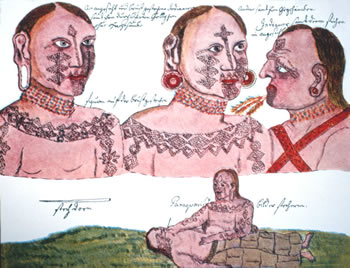TATTOOING IN THE GRAN CHACO OF SOUTH AMERICA
| |
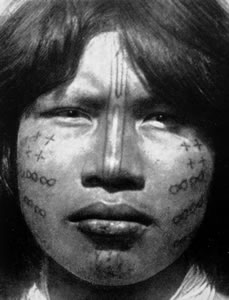 |
| |
Lengua woman with facial tattoos, 1930. |
Article © 2008 Lars Krutak
Lying some 1,000 miles to the south of the Amazon River, the Gran Chaco, which possibly derives its name from an indigenous Quechua word meaning "hunting ground," is a vast arid plain located at the center of the South American continent. This very hot and semi-desertic lowland region covers portions of Argentina, Bolivia, and Paraguay, and is drained by several rivers. On the whole, the entire region is barely suitable for human settlement, yet several groups of indigenous people continue to live here despite the harsh climate and landscape.
Although tattooing in the Chaco has been replaced by less painful and infective forms of body-painting in the modern-era, it had "magical" implications in the past and nearly all indigenous groups practiced it. Women generally displayed more abundant tattooing than men, and it was truly exceptional to find males as profusely tattooed as women.
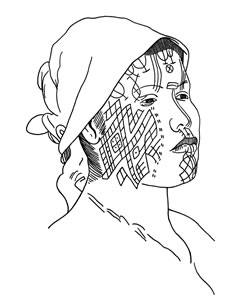
Tattooed Pilagá woman, 1920. |
|
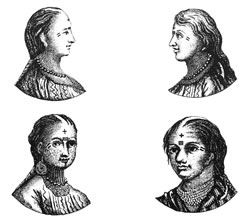 |
|
|
Tattooed Abipón women, 1750. |
|
Girls were first marked on their foreheads when five to seven years old, and with the passing of the years they received additional tattoos consisting of small circles, crosses, half-moons, and lines on their faces. By the time a girl reached maturity, her facial tattoos were finally completed at which time she was eligible for marriage.
Tattoo artists were almost always old women. They first traced the outline of the design on the client's face (or other body part) with charcoal. Then the tattooist punctured the facial skin with a small bundle of cactus thorns or a single bone awl dipped in a mixture of saliva and soot. Soon thereafter, the skin began to swell as a steady stream of blood ran down the client's face.
In 1750, the Jesuit missionary Martin
Dobrizhoffer provided a rare account of the
actual ritual among the now-extinct Abipón.
His observations are said to have been
typical of all Chaco groups that practiced
tattooing in the past:
Over the course of the days spent in tattooing, the girl is confined
to her father's dwelling and wrapped in a hide… She must abstain from
eating meat, fish, and other sorts of food, and is only allowed to feed
upon a small amount of fruit which grows on brambles and conduces much
towards cooling the blood.
Tattooing among the Abipón took place over four to five days with a
sharp cactus spine. The client returned everyday until the face, arms,
and breasts were full of tattoos. The Abipón paid for this with an
amount of blood, sweat, tears and moaning. When the girl became of age,
she laid her head upon the tattoo artist's lap, generally a woman of
many years, to become adorned and beautiful.
If the poor little girl complained, or escaped from the tattooist's
lap, she would be pinned down and told by the irritated old lady,
"Enough of this cowardice, you are a disgrace to our Nation, just
because I am tickling you with a few spines. Don't you know that you are
the descendant of those who had their pleasures and glory in being
wounded? You should be ashamed of yourself for being a timid little
creature!"
The Ritual Significance of Chacoan Tattooing
| |
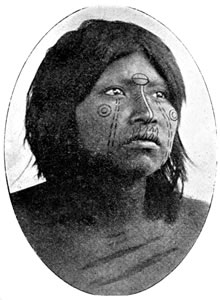 |
| |
Toba woman with facial tattooing, 1900.
|
From Dobrizhoffer's report, it does not appear that Abipón tattooing served merely as a form of "ornament" used to beautify the body. Rather, all Chaco women were tattooed in much the same way and with many of the same motifs, the only variation being in their positioning. In this way no particular woman could have hoped to gain aesthetic advantage over her "competitors" through tattooing. Furthermore, women fasted, were secluded and carefully covered during the tattoo ritual which seems to indicate that tattooing had a religious significance. These facts, combined with the belief that tattoo pigment and the tattooist's saliva were in themselves purificatory substances utilized to repel evil spirits, suggests that Chaco tattooing practice was not simply a form of facial adornment. It was something altogether different.
Carbon-based substances used as tattoo
pigment were considered in nature to be
prophylactic. The inherent power of the
pigment lay specifically in its connection
to fire, and among many indigenous peoples
of the Chaco, Brazil, and Patagonia, ash or
charcoal procured from fire was utilized
ritually as a radical means of purification.
For example, the Abipónes threw ashes in the
path of whirlwinds (thought to be passing
spirits) to repel them; the ancient Tupis,
at the ceremonial killing of enemy prisoners
taken in war, painted their bodies with
ashes to protect themselves from the
vengeful spirits of the soon to be deceased;
and Fuegian shamans heaped ashes upon
themselves to enter the realm of the
spirits.
Saliva procured from the venerated tattoo
artist had magical attributes ascribed to it
as well. It was a kind of sanctifying
substance that enhanced the efficacy of the
tattoo's overall magical power.
|
|
|
Mocoví body tattoos from the Argentinean Chaco (top). Mocoví woman tattooing a man (bottom), 1750. |
Thwarting Spirits and the Implications of Flowing Blood
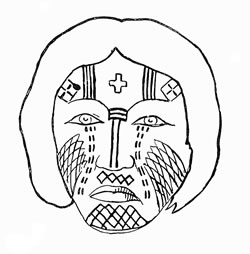
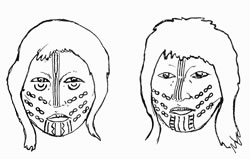
|
|
|
Facial tattooing of Toba (at top)
and Macá (bottom) women, 1930.
|
|
In the Gran Chaco, spirits helped or harmed individuals depending on how humans behaved with respect to them. In most cases, spiritual confrontations were believed to be result of human transgressions that in essence "activated" them. When a village was threatened by an epidemic, bad weather, or some other critical disturbance, Chaco peoples performed ceremonies aimed at curbing the influence of the supernatural entity or entities believed responsible. The accompanying ceremonials that followed were characterized by collective acts of dancing, drumming, chanting, and body painting which in their inherent power coerced, influenced, and/or repelled the supernatural intruders from the community.
The delicate condition of life into which an individual of the Chaco was thrust obviously served as a constant source of concern - spirits (good or bad) could be encountered anywhere and in anything. For a woman, however, the most immediate source of personal danger lay in her menstrual blood and when it flowed, she and her community became seriously exposed to malevolent spirits.
It seems to be a common idea that among all Chaco peoples menstruation was influenced by the new moon. The flowing blood of the girl "awakened" her sexual desire and was particularly enticing to evil spirits who were "angry with her." Although the attainment of puberty made the woman eligible for marriage, it also marked the beginning of her journey towards a series of critical life stages (e.g., childbirth, additional menses) that would not only come to shape her physical and emotional development, but would again expose her to supernatural dangers. Therefore, the tattooing initiation ceremonies at puberty had for their object, in part, to protect women against spiritual manifestations for the time being, and more importantly "to purify her once and for all from the evils associated with her sexual functions during the years to come."
As in many indigenous tattooing cultures
around the world, there was a unifying
thread of belief that the body's orifices
worked as passageways by which evil spirits
traveled to enter the human body to harm it.
Natural openings such as the mouth, the
nostrils, the eyes, and ears were especially
sensitive to the actions of spiritual
entities, and individuals who left their
heads, bodies, or faces uncovered (and hence
unprotected) were especially at risk.
Among the Toba, Choroti, and Mataco of the Gran Chaco, a girl
arriving at puberty was kept secluded in her house for a period of four
to five days and her face and entire body was carefully covered (or
painted) because "evil demons" were constantly "attacking her." She was
also obliged to fast strictly, ingesting only vegetable products.
Sometimes she was permitted to uncover herself and exit the dwelling,
but only if she moved to the center of a dance circle where a group of
men (Toba) or women (Choroti) wielding deer hoof rattles attempted to
shield her from the incorrigible spirits by whom she was exposed to for
the moment.
| |
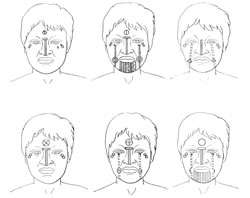
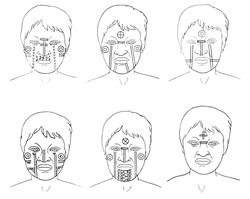 |
| |
Facial tattooing of Choroti (top)
and Mataco women (bottom), 1900. |
As noted, initiates were frequently subjected to periods of
ceremonial fasting or restrictions in diet prior to or after the
tattooing operation. According to Dobrizhoffer, the 18th century Jesuit
missionary, Abipón tattoo initiates were restricted to a diet of a
little fruit which grows upon brambles because it "cooled" the woman's
blood. In most cases, particular foodstuffs, especially those that were
associated with blood in their raw state (like meat and fish), were
prohibited from being ingested due to the fear of evil spirits entering
into the body with the food itself causing madness. Of course, such food
restrictions in the Gran Chaco also stemmed from the idea that
particular prey animals (armadillo, peccary, rhea, etc.) were associated
with spirit "Masters" who, if not properly propitiated, would either
bring illness to the community or cause the game animals to disappear.
The meat of predatory animals was particularly forsaken especially if
that species performed a key symbolic role in mythology (e.g., jaguar,
puma, hunting dogs, particular birds, etc.) or if the predatory or prey
animal was one believed to "share immortality with men [and women]."
Therefore, the result of these extended sets of food restrictions
encountered in Chacoan puberty and tattooing rites was not only to
enhance the power of resistance by frustrating the evil spirit's
possessive power, but also to declare that particular animals were
equivalent to humans (via reincarnation) and should not be eaten during
the tabooed period.
For the Chacoan peoples it appears that there exists a commonly
shared condition of humanity between both humans and particular animals.
If this is true, perhaps Brazilian anthropologist Viveiros de Castro is
correct when he says that there is a "universal Amerindian notion" that
some:
animals (predators) and spirits see humans as animals (as game or
prey) to the same extent that game animals see humans as spirits or
as predator animals…Animals see their food as human food (jaguars
see blood as manioc beer, vultures see the maggots in rotting meat
as grilled fish); they see their bodily attributes (fur, feathers,
claws, beaks) as body decorations or cultural instruments; they see
their social system as organized in the same way as human
institutions are (with chiefs, shamans, ceremonies, exogamous
moieties, and whatnot) …[and they believe] that any animal can be
human.
What this means, ultimately, is that there is more "being" to an
animal than meets the eye.
Museum photo gallery of these images may
be seen here.
Literature
Karsten, Rafael. (1932). Indian Tribes of
the Argentine and Bolivian Chaco.
Helsingfors: Ethnological Studies, Societas
Scientiarum Fennica, vol. 4(1).
Métraux, Alfred. (1940). "Indians of the Gran Chaco: Ethnography of
the Chaco."
Pp. 197-370 in Handbook of South American Indians (J.H. Steward, ed.),
vol. 1, The Marginal Tribes. Washington: U.S. government Printing
Office.
Nordenskiold, Erland. (1910). Indianlif I El Gran Chaco (Südaamerika).
Stockholm.
Outes, Félix F. and Carlos Bruch. (1910). Los Aborígenes de la
República Argentina. Buenos Aires: Ángel Estrada y Cía.
Rosen, Eric von. (1924). Popular Account of Archaeological Research
during the Swedish Chaco-Cordillera-Expedition, 1901-1902. Stockholm.
C.E. Fritze.
Viveiros de Castro, Eduardo. (2004). "Exchanging Perspectives: the
Transformation of Objects into Subjects in Amerindian Ontologies."
Common Knowledge 10(3): 463-484. |





